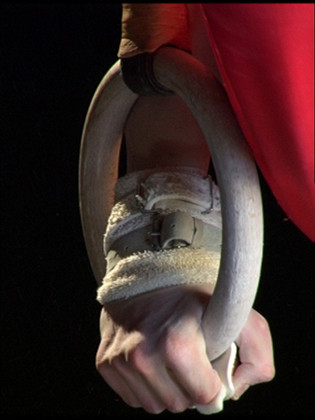João Penalva
20 Jul - 24 Aug 2012

© João Penalva
The Prize Song, 2001
Single video projection, 4x3 aspect ratio, colour, sound
Film still
The Prize Song, 2001
Single video projection, 4x3 aspect ratio, colour, sound
Film still
JOÃO PENALVA
The Prize Song
20 July - 24 August 2012
Two rings hang in front of a deep black background; hands, powdered and bandaged, reach up to them, but the rest of the body is invisible in the extreme close-up of the shot. Suddenly the body jerks up, a red leotard clothing legs and torso, and the camera remains trained on the dynamic movements. A brief pause in a position of balance, the strong upper arms – threaded by muscles and veins – are visible for a moment. Then the momentum again effaces the orientation, catapulting the gymnast into a new pose, before pausing once again for a few seconds. These images tell us something: they present the male athlete and his control over his own body as a sort of graphic torso. Even more emphatic is the sound accompanying the images: the rubbing of the leather straps always starts up when the image is focused on one of the heavily strained body parts; and the whiplash effect of the ropes and the presence of the hooks gives the voluntary gymnastics performance the air of a process of torture. After the dynamic finish the body disappears from the picture, the wooden rings clack against each other; and it is their noiseless swinging that ends the video sequence. No applause. No bows from the athlete. The film loop of barely three minutes begins again.
(Ralf Christofori, taken from ex. Cat. Body Power / Power Play: Views on Sport in Contemporary Art. Württembergischer Kunstverein, Stuttgart / Hatje Cantz Verlag, 2002)
Simon Lee Gallery is delighted to announce the presentation of João Penalva’s single channel video The Prize Song. Made just over a decade ago, the work formed the core of Penalva’s participation in the Venice Biennale, where the artist represented Portugal in 2001, and is now shown for the first time in the UK.
João Penalva was born in Lisbon in 1949 and has lived and worked in London since 1976. He was awarded the DAAD Berlin Artist’s Residency in 2003/2004. He represented Portugal in the XXIII Bienal Internacional de São Paulo, 1996, and in the XLIX Biennale di Venezia, 2001. He exhibited also in the Berlin Biennale 2, 2001, and the 2002 Biennale of Sydney. Other solo exhibitions include: Camden Arts Centre, London, Contemporary Art Centre, Vilnius, Galerie im Taxispalais, Innsbruck and Tramway, Glasgow, 2000; Rooseum, Malmö, 2002; Institute of Visual Arts, Milwaukee, and The Power Plant, Toronto, 2003; Serralves Museum, Oporto, and Ludwig Museum Budapest, 2005; Irish Museum of Modern Art, 2006; DAAD Gallery, Berlin, and Mead Gallery, University of Warwick, England, 2007; Lunds Konsthall, Lund, Sweden, 2010, Centro de Arte Moderna, Calouste Gulbenkian Foundation, Lisbon, 2011, and at Brandts Kunsthallen, Odense, Denmark, 2012.
The Prize Song
20 July - 24 August 2012
Two rings hang in front of a deep black background; hands, powdered and bandaged, reach up to them, but the rest of the body is invisible in the extreme close-up of the shot. Suddenly the body jerks up, a red leotard clothing legs and torso, and the camera remains trained on the dynamic movements. A brief pause in a position of balance, the strong upper arms – threaded by muscles and veins – are visible for a moment. Then the momentum again effaces the orientation, catapulting the gymnast into a new pose, before pausing once again for a few seconds. These images tell us something: they present the male athlete and his control over his own body as a sort of graphic torso. Even more emphatic is the sound accompanying the images: the rubbing of the leather straps always starts up when the image is focused on one of the heavily strained body parts; and the whiplash effect of the ropes and the presence of the hooks gives the voluntary gymnastics performance the air of a process of torture. After the dynamic finish the body disappears from the picture, the wooden rings clack against each other; and it is their noiseless swinging that ends the video sequence. No applause. No bows from the athlete. The film loop of barely three minutes begins again.
(Ralf Christofori, taken from ex. Cat. Body Power / Power Play: Views on Sport in Contemporary Art. Württembergischer Kunstverein, Stuttgart / Hatje Cantz Verlag, 2002)
Simon Lee Gallery is delighted to announce the presentation of João Penalva’s single channel video The Prize Song. Made just over a decade ago, the work formed the core of Penalva’s participation in the Venice Biennale, where the artist represented Portugal in 2001, and is now shown for the first time in the UK.
João Penalva was born in Lisbon in 1949 and has lived and worked in London since 1976. He was awarded the DAAD Berlin Artist’s Residency in 2003/2004. He represented Portugal in the XXIII Bienal Internacional de São Paulo, 1996, and in the XLIX Biennale di Venezia, 2001. He exhibited also in the Berlin Biennale 2, 2001, and the 2002 Biennale of Sydney. Other solo exhibitions include: Camden Arts Centre, London, Contemporary Art Centre, Vilnius, Galerie im Taxispalais, Innsbruck and Tramway, Glasgow, 2000; Rooseum, Malmö, 2002; Institute of Visual Arts, Milwaukee, and The Power Plant, Toronto, 2003; Serralves Museum, Oporto, and Ludwig Museum Budapest, 2005; Irish Museum of Modern Art, 2006; DAAD Gallery, Berlin, and Mead Gallery, University of Warwick, England, 2007; Lunds Konsthall, Lund, Sweden, 2010, Centro de Arte Moderna, Calouste Gulbenkian Foundation, Lisbon, 2011, and at Brandts Kunsthallen, Odense, Denmark, 2012.
